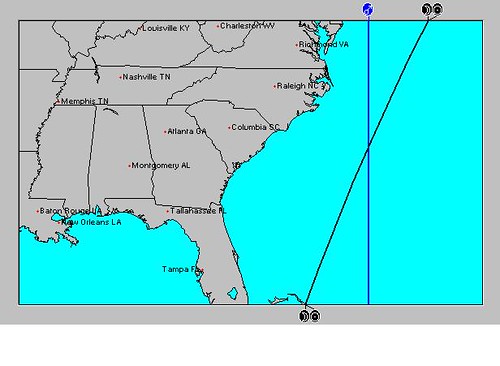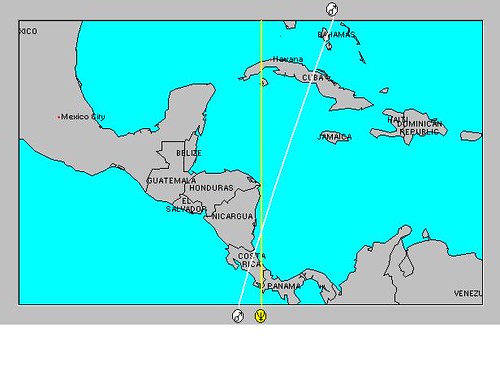The solar eclipse of May 20, 2012 sets up some important sensitive points in the northern and western hemispheres that will be activated over the coming months and carry the promise of severe weather when activated. Here are some brief explanations and time frames.
 The first place lies about 350 miles off the South Carolina coast. Here we see a crossing between the Sun and Moon, which were setting at that time, and Mars, which was directly overhead. The idea is that when these positions are activated later on by other planets arriving at those zodiacal degrees they held, certain weather patterns will develop there.
The first place lies about 350 miles off the South Carolina coast. Here we see a crossing between the Sun and Moon, which were setting at that time, and Mars, which was directly overhead. The idea is that when these positions are activated later on by other planets arriving at those zodiacal degrees they held, certain weather patterns will develop there. June 13-14
On these dates, the planet Jupiter will arrive at the exact degree the Sun and Moon held at the time of eclipse, and Venus will arrive at the square or 90 degree point to the position that Mars held. This carries the potential for the development of a tropical system around this area (73W/33N) in and around these dates.
Central America
An even more important set up occurs off the eastern coasts of Nicaragua and Costa Rica as seen in the map below.
 Here we find that at the time of the eclipse the Sun and Moon were setting over this area and the planet Neptune was directly below any observer at that point. In astrometeorology, Neptune is known for its tendency to increase tropical moisture. This implies that, when activated, tropical systems may develop here--or at least tropical moisture will be abundant even if a tropical low does not specifically form.
Here we find that at the time of the eclipse the Sun and Moon were setting over this area and the planet Neptune was directly below any observer at that point. In astrometeorology, Neptune is known for its tendency to increase tropical moisture. This implies that, when activated, tropical systems may develop here--or at least tropical moisture will be abundant even if a tropical low does not specifically form. August 21-24
At this time Sun will trigger the solar eclipse degree and oppose Neptune. Watch for a possible tropical system or heavy rains to affect the area in and around the east coasts of Nicaragua and Costa Rica.
September 1-3
Around this time Mercury will activate the solar eclipse and oppose Neptune once again increasing the likelihood of heavy rains or a tropical system over the eastern coasts of Honduras and Nicaragua. At this time the abovementioned area about 350 miles of the South Carolina coast will also be activated, indicating a possible tropical system or severe weather there.
October 2-4
Venus will spark the solar eclipse now and also oppose Neptune off the eastern coasts of Nicaragua and Costa Rica. The Venus-Neptune combination charges the atmosphere with saturating humidity provoking heavy downpours. This may manifest as a tropical system.
October 6-8
Right on the heels of Venus' opposition to Neptune we find Mars triggering the solar eclipse and squaring Neptune over the same area. Torrential downpours from acute storms (possibly a tropical system) correlate with Mars-Neptune aspects.
October 28-30
Mercury will perform the same manuever instigating tropical rains in and around Nicaragua and Costa Rica.
November 10-14
Both Mercury and Neptune will now activate the solar eclipse and square each other. Indications in another key chart adds to this itimating that any storm system developing over Nicaragua and Costa Rica now could be very powerful.
November 20-22
The Sun activates the solar eclipse and Neptune increasing tropical moisture while other indications show Mercury and Mars add powerful winds into the mix. This sounds like a tropical system over Nicaragua and Costa Rica.
Based on similar astrometeorological long-range techniques, I was able to predict 10 tropical systems that developed during Hurricane Season 2011. Hurricane Season 2011 Forecast Results
June 22-30, 2012 Long-range Weather Forecast
June 10-12, 2012 Long-range Weather Forecast
June 4-7, 2012 Long-range Weather Forecast
Hurricane Season 2011 Forecast Results
Hurricane Risk-Management
Texas Summer 2012
New Weather Alternative Website
Overview of UK Winter 2012-13
The Winters of 2011-14
Fulfilled Long-range Forecasts for Hurricane Season 2010
Introduction to the Weather Alternative
No comments:
Post a Comment